
Silver Price Surge
The world is witnessing an extraordinary rally in silver prices, with the precious metal recently hitting the $50 per ounce mark—a level not seen in over forty years. This dramatic surge has captured the attention of investors, industry leaders, and policymakers alike, as the implications ripple through financial markets and the broader economy.
The surge in silver prices is being driven by a combination of factors. Economic uncertainty, persistent inflation, and concerns over currency stability have prompted investors to seek safe-haven assets. Silver, often considered the “poor man’s gold,” has become a focal point for both institutional and retail investors looking to hedge against market volatility. Trading volumes on major exchanges have soared, and some bullion dealers are reporting shortages as demand outpaces supply.
Also Read: Silver Price Hits $50 Four-Decade High Raises Market Questions
This price rally is not occurring in isolation. The global commodities market has been experiencing heightened volatility, with precious metals leading the charge. Analysts point to a mix of geopolitical tensions, supply chain disruptions, and increased industrial demand—particularly from the electronics and renewable energy sectors—as key contributors to the current silver boom. As a result, market participants are closely monitoring developments, wary of potential corrections or further surges.
Amid ongoing concerns about inflation and currency fluctuations, investors are increasingly turning to precious metals as a safeguard. Silver, often seen as a more accessible alternative to gold, has experienced a notable uptick in demand. Trading platforms have reported record volumes, and some dealers are facing shortages as retail buyers rush to secure physical silver.
Industries that rely heavily on silver, such as electronics, solar energy, and medical device manufacturing, are preparing for the impact of elevated prices. Companies are reassessing supply contracts and exploring ways to reduce silver usage or substitute alternative materials. Some manufacturers warn that prolonged high prices could lead to increased costs for consumer goods, particularly in technology and renewable energy sectors.
The dramatic movement in silver prices has caught the attention of central banks and policy makers. Some financial authorities are reviewing their reserves and considering adjustments to their precious metal holdings. Economic analysts suggest that if the trend continues, it could influence monetary policy decisions, especially in countries with significant exposure to commodity markets.
Market observers are drawing comparisons to the silver boom of 1980, when prices last reached similar heights. While the current environment is shaped by different economic drivers, the rapid ascent has fueled speculation about potential market corrections. Experts caution that volatility may persist, urging investors to remain vigilant and diversify their portfolios.
Consumers are beginning to feel the effects of rising silver prices, particularly in jewelry and electronics. Retailers report increased interest in silver products, both as investments and collectibles. Looking ahead, analysts predict continued fluctuations as markets digest the new price reality and assess the broader economic implications.
Source Links: